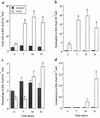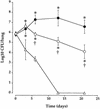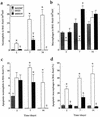Role of adenylate cyclase-hemolysin in alveolar macrophage apoptosis during Bordetella pertussis infection in vivo
- PMID: 9529102
- PMCID: PMC108109
- DOI: 10.1128/IAI.66.4.1718-1725.1998
Role of adenylate cyclase-hemolysin in alveolar macrophage apoptosis during Bordetella pertussis infection in vivo
Abstract
Bordetella pertussis induces in vitro apoptosis of murine alveolar macrophages by a mechanism that is dependent on expression of bacterial adenylate cyclase-hemolysin. Using a murine respiratory model, we found in this study that intranasal infection with a parental B. pertussis strain, but not with an isogenic variant deficient in the expression of all toxins and adhesins, induced a marked neutrophil accumulation in the bronchoalveolar lavage fluid and an early decrease in macrophage numbers. These phenomena paralleled a time-dependent rise in the proportion of apoptotic nuclei, as detected by flow cytometry, and of macrophages which had engulfed apoptotic bodies. Apoptotic death of bronchopulmonary cells was observed exclusively following intranasal infection with bacteria reisolated from lungs of infected animals and not with B. pertussis collected after in vitro subculture. Using the terminal deoxynucleotidyltransferase-mediated dUTP-biotin nick end labeling technique coupled to fluorescence microscopy and morphological analysis, we established that the apoptotic cells in bronchoalveolar lavage fluids were neutrophils and macrophages. Histological analysis of the lung tissues from B. pertussis-infected mice showed increased numbers of apoptotic cells in the alveolar compartments. Cellular accumulation in bronchoalveolar lavage fluids and apoptosis of alveolar macrophages were significantly attenuated in mice infected with a mutant deficient in the expression of adenylate cyclase-hemolysin, indicating a role of this enzyme in these processes.
Figures







Similar articles
-
Bordetella pertussis induces apoptosis in macrophages: role of adenylate cyclase-hemolysin.Infect Immun. 1993 Oct;61(10):4064-71. doi: 10.1128/iai.61.10.4064-4071.1993. Infect Immun. 1993. PMID: 8406793 Free PMC article.
-
Pertussis toxin and extracytoplasmic adenylate cyclase as virulence factors of Bordetella pertussis.J Infect Dis. 1984 Aug;150(2):219-22. doi: 10.1093/infdis/150.2.219. J Infect Dis. 1984. PMID: 6088647
-
Induction of macrophage apoptosis by Bordetella pertussis adenylate cyclase-hemolysin.FEMS Microbiol Lett. 1995 Dec 1;134(1):27-32. doi: 10.1111/j.1574-6968.1995.tb07909.x. FEMS Microbiol Lett. 1995. PMID: 8593951
-
Molecular aspects of Bordetella pertussis pathogenesis.Int Microbiol. 1999 Sep;2(3):137-44. Int Microbiol. 1999. PMID: 10943406 Review.
-
The concept of pertussis as a toxin-mediated disease.Pediatr Infect Dis. 1984 Sep-Oct;3(5):467-86. doi: 10.1097/00006454-198409000-00019. Pediatr Infect Dis. 1984. PMID: 6093069 Review.
Cited by
-
Role of Major Toxin Virulence Factors in Pertussis Infection and Disease Pathogenesis.Adv Exp Med Biol. 2019;1183:35-51. doi: 10.1007/5584_2019_403. Adv Exp Med Biol. 2019. PMID: 31376138 Free PMC article.
-
Bacterial Toxins as Pathogen Weapons Against Phagocytes.Front Microbiol. 2016 Feb 1;7:42. doi: 10.3389/fmicb.2016.00042. eCollection 2016. Front Microbiol. 2016. PMID: 26870008 Free PMC article. Review.
-
Cyclic AMP-Elevating Capacity of Adenylate Cyclase Toxin-Hemolysin Is Sufficient for Lung Infection but Not for Full Virulence of Bordetella pertussis.Infect Immun. 2017 May 23;85(6):e00937-16. doi: 10.1128/IAI.00937-16. Print 2017 Jun. Infect Immun. 2017. PMID: 28396322 Free PMC article.
-
Pertussis toxin and lipopolysaccharide influence phagocytosis of Bordetella pertussis by human monocytes.Infect Immun. 2001 Dec;69(12):7635-41. doi: 10.1128/IAI.69.12.7635-7641.2001. Infect Immun. 2001. PMID: 11705943 Free PMC article.
-
Selective Enhancement of the Cell-Permeabilizing Activity of Adenylate Cyclase Toxin Does Not Increase Virulence of Bordetella pertussis.Int J Mol Sci. 2021 Oct 28;22(21):11655. doi: 10.3390/ijms222111655. Int J Mol Sci. 2021. PMID: 34769101 Free PMC article.
References
-
- Ameisen J C, Estaquier J, Idziorek T. From AIDS to parasite infection: pathogen-mediated subversion of programmed cell death as a mechanism for immune dysregulation. Immunol Rev. 1994;142:9–51. - PubMed
-
- Boschwitz J S, Batanghari J W, Kedem H, Relman D A. Bordetella pertussis infection of human monocytes inhibits antigen-dependent CD4 T cell proliferation. J Infect Dis. 1997;176:678–686. - PubMed
-
- Confer D L, Eaton J W. Phagocyte impotence caused by an invasive bacterial adenylate cyclase. Science. 1982;217:948–950. - PubMed
-
- Cox G, Crossley J, Xing Z. Macrophage engulfment of apoptotic neutrophils contributes to the resolution of acute pulmonary inflammation in vivo. Am J Respir Cell Mol Biol. 1995;12:232–237. - PubMed
-
- Douglas R S, Tarshis A D, Pletcher C H, Nowell P C, Moore J S. A simplified method for the coordinate examination of apoptosis and surface phenotype of murine lymphocytes. J Immunol Methods. 1995;188:219–228. - PubMed
Publication types
MeSH terms
Substances
LinkOut - more resources
Full Text Sources
Medical

